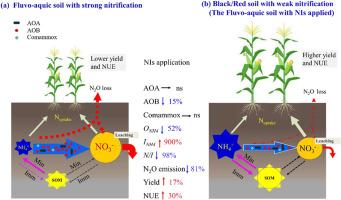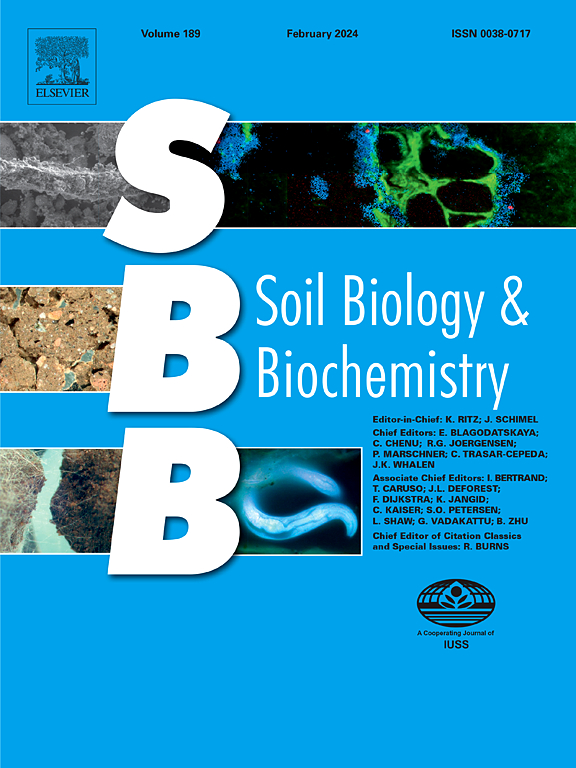Nitrification inhibitor induced microbial NH4+-N immobilization improves maize nitrogen use efficiency in strong ammonia oxidation soil
IF 9.8
1区 农林科学
Q1 SOIL SCIENCE
引用次数: 0
Abstract
Nitrification inhibitors (NIs) have been acknowledged since 1970s for their potential to mitigate N2O emissions, enhance fertilizer nitrogen use efficiency (NUE), and improve crop productivity. However, their effectiveness in improving yield and NUE varies significantly across different soil types, with the underlying mechanisms largely unexplored. This study integrates laboratory 15N labeling incubation experiments with field trials to evaluate the influence of a specific NI, nitraprin, on soil gross N transformation rates, N2O emissions, maize yield and NUE across three distinct soil types prevalent in China's major crop production zones. These soils include acidic black soil at GZL site, alkaline fluvo-aquic soil at XC site, and acidic red soil at QJ site. The alkaline fluvo-aquic soil (XC) exhibited the highest gross nitrification rates (ONH4) and cumulative N2O emissions, while also showing the lowest immobilization rate of NH4+-N (INH4). Conversely, the acidic black soil (GZL) had opposite trends. NI application lead to a significant reduction in ONH4 by 23–53% and in N2O emissions by 48–85%. Notably an increase in maize yield (by 18.7%) and NUE (by 30.3 %) were observed exclusively at XC. NI addition notably enhanced INH4 at XC, due to the suppression of a high nitrification rate, reduced the N losing risk (N/I ratio) and consequently supported higher maize yield. Further analyses highlighted that autotrophic nitrification, predominantly mediated by ammonia-oxidizing bacteria (AOB), particularly the AOB Nitrosospira cluster 3a.2 (D11), is pivotal in regulating soil N2O emissions and is sensitive to NI addition. This study underscores the significant role that the interplay between ONH4 and INH4 plays in influencing maize yield, NUE, and the effectiveness of NIs across various soil types. These insights are crucial for developing tailored N management strategies that aim to maximize NUE and minimize N2O emissions.


硝化抑制剂诱导微生物NH4+-N固定化提高了强氨氧化土壤中玉米氮素利用效率
自20世纪70年代以来,硝化抑制剂(NIs)已被公认为具有减少N2O排放,提高肥料氮利用效率(NUE)和提高作物生产力的潜力。然而,它们在提高产量和氮肥利用效率方面的有效性在不同土壤类型之间存在显著差异,其潜在机制在很大程度上尚未探索。本研究将实验室15N标记培养实验与田间试验相结合,以评估特定NI(硝酰胺)对中国主要作物生产区三种不同土壤类型土壤总氮转化速率、N2O排放、玉米产量和氮肥利用效率的影响。这些土壤包括GZL站点的酸性黑土、XC站点的碱性流-潮土和QJ站点的酸性红壤。碱性潮土(XC)的总硝化速率(ONH4)和累积N2O排放量最高,而NH4+-N (INH4)的固定化速率也最低。而酸性黑土(GZL)则相反。NI的应用导致ONH4排放量显著减少23-53%,N2O排放量显著减少48-85%。值得注意的是,仅在XC,玉米产量(18.73%)和氮肥利用率(30.32%)均有显著提高。添加NI显著提高了XC时的INH4,这是由于抑制了高硝化速率,降低了氮损失风险(N/I比),从而支持了玉米产量的提高。进一步分析表明,自养硝化作用主要由氨氧化菌(AOB)介导,尤其是亚硝化螺旋体群3a.2(D11)在调节土壤N2O排放中起关键作用,对NIs的修正非常敏感。本研究强调了ONH4和INH4之间的相互作用在影响不同土壤类型的玉米产量、氮肥利用效率和NIs有效性方面的重要作用。这些见解对于制定针对性的氮管理策略至关重要,这些策略旨在最大限度地提高氮肥利用效率,最大限度地减少N2O排放。
本文章由计算机程序翻译,如有差异,请以英文原文为准。
求助全文
约1分钟内获得全文
求助全文
来源期刊

Soil Biology & Biochemistry
农林科学-土壤科学
CiteScore
16.90
自引率
9.30%
发文量
312
审稿时长
49 days
期刊介绍:
Soil Biology & Biochemistry publishes original research articles of international significance focusing on biological processes in soil and their applications to soil and environmental quality. Major topics include the ecology and biochemical processes of soil organisms, their effects on the environment, and interactions with plants. The journal also welcomes state-of-the-art reviews and discussions on contemporary research in soil biology and biochemistry.
 求助内容:
求助内容: 应助结果提醒方式:
应助结果提醒方式:


